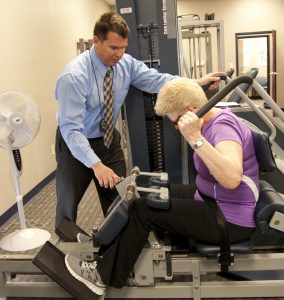Is Strength Training Better Than Aerobic Training for Heart Disease Patients?
At Exercise Inc, we have always believed lifting weights can improve the health of your heart just as much or better than aerobic training. Part of our reasoning is due to the fact that the body functions as a systemic organism, with every system being completely connected with and dependent on the health of all other systems. Your muscular system is the largest system in your body, comprising about 40% of the average healthy person’s body mass. It would only make sense that stressing your muscles with high intensity strength training would also be the best way to force your cardiovascular system—especially your heart—to improve.
 Cardiovascular disease has the highest global mortality rate of any disease, with coronary heart disease accounting for almost half of cardiovascular disease related deaths. The traditional approach from the medical field for improving cardiac disease risk factors and for recovery from coronary artery bypass surgery has been moderate intensity, continuous aerobic training (walking on a treadmill), otherwise known as cardiac rehab. This approach has been proven to be effective based on the positive association between higher cardiorespiratory fitness and lower all-cause mortality and cardiac-related mortality. Even with its success rate, only 10% of eligible patients typically enroll in a cardiac rehab program, even when their insurance company is paying for it. There could be a number of reasons for this lack of participation. My guess is that most people don’t want to spend three days a week in a supervised exercise program, and most people probably don’t want to go to a hospital to exercise.
Cardiovascular disease has the highest global mortality rate of any disease, with coronary heart disease accounting for almost half of cardiovascular disease related deaths. The traditional approach from the medical field for improving cardiac disease risk factors and for recovery from coronary artery bypass surgery has been moderate intensity, continuous aerobic training (walking on a treadmill), otherwise known as cardiac rehab. This approach has been proven to be effective based on the positive association between higher cardiorespiratory fitness and lower all-cause mortality and cardiac-related mortality. Even with its success rate, only 10% of eligible patients typically enroll in a cardiac rehab program, even when their insurance company is paying for it. There could be a number of reasons for this lack of participation. My guess is that most people don’t want to spend three days a week in a supervised exercise program, and most people probably don’t want to go to a hospital to exercise.
Growing evidence suggests that strength training is also a safe and effective approach for patients with coronary artery disease. In older adults, strength training has been shown to increase cardiorespiratory fitness just as well as aerobic training. And, of course, strength training will make you stronger. Just being stronger has a huge association with improved prognosis, survival, and performing activities of daily living. All promote independent living and a quicker return to work after a cardiac event. Additionally, strength training has been shown to improve co-morbidities associated with heart disease, such as sarcopenia (age related muscle loss), frailty, falls, arthritis, diabetes, depression, cognitive impairment, peripheral vascular disease, and renal failure. Despite this evidence, very few medical professionals recommend strength training as a form of rehabilitation for heart disease patients. Their reasoning is usually based on their perceptions of how most people lift weights. Most medical professionals don’t understand that properly performed strength training is much safer than aerobic training. But, in their defense, there are very few strength training programs that focus on proper breathing, and eliminating momentum the way we do at Exercise Inc.

Last month (May 2017) a meta-analysis study was published evaluating all studies published on the effect of resistance training on cardiovascular fitness and muscular strength in coronary artery disease. The study found strength training alone improved aerobic fitness to a similar degree as aerobic training in coronary heart disease patients. In other words, strength training was able to make the same measurable cardiovascular improvements in patients with heart disease as walking on a treadmill. The authors of the study stated that strength training can provide cardiovascular improvements equivalent in magnitude to aerobic training, which may contribute to a reduced mortality risk. Additionally, the overall affects of improving strength and cardiovascular fitness were greatest when strength training was combined with walking, which is exactly what we recommend at Exercise Inc.
The Health Professionals Follow-Up study reported a 23% reduction in the risk of fatal and non-fatal heart attacks in men who reported 30 minutes or more of strength training per week, which is greater than the 18% reduction for men who reported walking 3.5 hours per week. The mechanism of the reduction in heart attacks has not been fully identified in resistance training, but both cardiorespiratory fitness and muscle strength have been linked to reduced mortality, and strength training improves both.
In spite if this evidence, most doctors are still reluctant to recommend strength training to heart disease patients. They typically state that it is just too strenuous or dangerous. Well, there is another caveat to this study that addresses the safety issue. Twenty of the studies reported adverse events that occurred during training. There were 64 cardiovascular complications that occurred during training—63 occurred during aerobic training, and only one event occurred during strength training. It looks like the doctors are concerned about the wrong type of training being safe. Based on this study, strength training is a much safer form of training for heart disease patients, especially in regards to being safe for the heart.
Maybe it’s time to rethink our recommendations for heart health and hit the gym for some strength training.
Stay Strong,
Bo Railey

